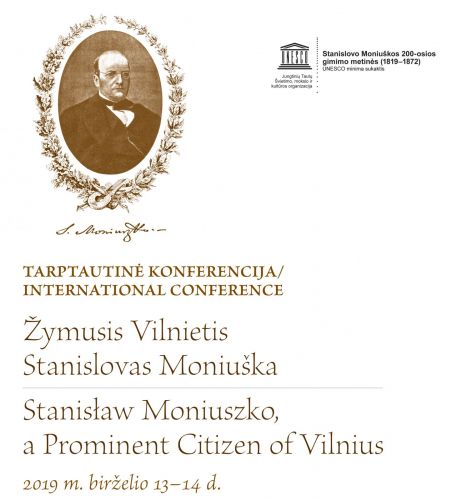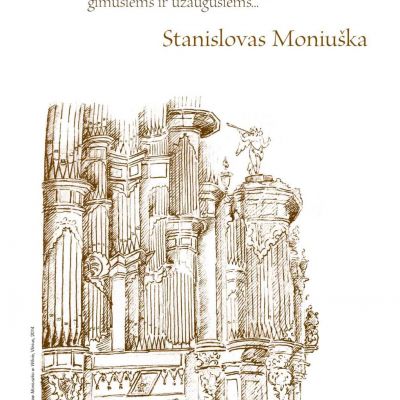„Traditional and cultural elements from different nations in Stanisław Moniuszko’s songs”

Lilianna Zalesińska, art historian and soloist (mezzo-soprano), member of the Polish Musicians‘ Society
***
200 years have passed since the birth of Stanisław Moniuszko, and 176 since the publication of the first volume of his Śpiewniki domowe (Songbooks for Home Use). In Poland, we tend to have the so-called ‘Kraków-Warsaw’ perspective on Moniuszko’s output,[1] whereby his songs are examined on the basis of their ethnically Polish qualities – we seek out what we find familiar.[2] However, this is not the only way to look at the music in Śpiewniki domowe – they are much more diverse than what may be perceived at first glance. A closer look at the collection reveals that the ‘Polishness’ of a lot of compositions contained therein is debatable from our modern perspective. The reason for that phenomenon is that the mentality of people in Moniuszko’s times still harked back to the Polish Kingdom from before it was partitioned and occupied in the late eighteenth century. Rzeczpospolita Obojga Narodów (literally the Commonwealth of Both Nations), comprising the Polish Crown and the Grand Duchy of Lithuania, was still a valid concept for the descendants of its citizens living in the same place, but under altered political circumstance and divided by the boundaries set up by the occupiers, well into the nineteenth century, long before the modern definition of Polishness was shaped in the twentieth century. The country, which accommodated elements of different national cultures, existed „in a heterogeneous or hybrid state, as one organism”.[3] The term ‘Pole’ (a Polish person) at that time applied to someone living in what used to be the Polish-Lithuanian Commonwealth, a country inhabited, mainly, by ethnic Poles, Ukrainians, Lithuanians and Belarusians.[4] Moniuszko referred to himself as ‘Lithuanian’, which meant that he was a citizen of the former Grand Duchy of Lithuania. Even though it may sound rather astonishing to the twenty-first-century Polish citizen, we must not forget that Moniuszko was a long-time inhabitant of Wilno (now the capital of the Republic of Lithuania better known as Vilnius), where he was the driving force behind various musical initiatives in and around the city.[5] During the times of Mickiewicz and, later, Moniuszko, the term ‘homeland’ did not equal to the ‘state’.[6] As a consequence, Moniuszko considered the (former) Grand Duchy of Lithuania to be his ‘country’. He familiarised himself with ‘songs’ sung in what is today the Republic of Belarus, where he was born (and which he later frequently visited), in and around Wilno, and, later on in his life, the city of Warsaw. He also drew inspirations from the region of Małopolska (Lesser Poland), rich in peculiar artistic features. Moniuszko stayed in the region’s foremost city, Kraków, during one of his journeys. He visited the Wawel with its historic artefacts closely related to the beginnings of Poland as a state, and was quite emotional when he was describing the visit in his letters.[7]
To make the overall picture of Moniuszko’s sources and inspirations complete, we must not forget some Russian motifs mostly picked up during his ‘business’ trips to Saint Petersburg, as well as German influences connected with his studies in Berlin and first-hand experience of the German lieder tradition, which – as he mentioned himself – he greatly admired and which inspired him to publish his songbooks. Moniuszko has commented: „My song collection covers three discrete genres: ballads, romances and pastorals, and there is no other reward for the composer than to be of service to the singers (…) The German musicians are willing to draw inspiration from the appropriate choice of poetry – their Schiller, Goethe and other famous poets have often been graced by the most splendid melodies. It is regrettable that in our own country no musician has attempted to use the fine products of our poets – they have been waiting to serve the singers for too long.”[8]
Therefore, Moniuszko’s songs encompass the whole spectrum of contemporary Polish culture: from the mazurka that opens Gdyby kto mnie kochał szczerze, through several krakowiaks (e.g. 2 Krakowiaki J. Korsaka), to melodies of Ukrainian origin. Kozak was based on the Ukrainian folk melody Stoi jawor nad wodą,[9] and we can also find Ukrainian dumkas in Ruta, Wyjazd na wojnę and Korale”.[10] Musical inspirations are complemented by literary ones: the popular German lieder Kennst du das Land based on the text from Wolfgang von Goethe’s novel Wilhelm Meisters Lehrjahre, also set to music by Franz Schubert, Ludwig van Beethoven and Ferenc Liszt, bears the title Znasz-li ten kraj (a loose translation by Adam Mickiewicz) in Moniuszko’s work. The composer also set Goethe’s poem Heiden Röslein (Polish version titled Polna różyczka), popularised by Schubert. The shape of some of Moniuszko’s songs is also derived from the works by the German composer Carl Loewe.[11] This ‘German thread’ is all the more apparent today, as chamber singers closely study the German lieder repertory as part of their school curriculum (especially works composed by Franz Schubert), which they later use in concert practice.
Moniuszko is also an author of Piosnki wieśniacze znad Niemna i Dźwiny, in which he sets to music the same-titled poems by Jan Czeczot from the collection of his Piosnki wieśniacze znad Niemna i Dźwiny, niektóre przysłowia i idiotyzmy w mowie sławiano-krewickiej z postrzeżeniem nad nią uczynionymi. They form the writer’s reflections on the Belarusian language. Volumes 1 and 2 of Śpiewniki domowe contain songs which use poems written by Ukrainian-based authors, such as Michał Grabowski, Aleksander Groza, Antoni Malczewski and, in the fifth volume, Jan Prusinowski.[12] Influences of Lithuanian folk music are more difficult to trace,[13] but the songbooks contain several songs based on poems by Ignacy Kraszewski – a contemporarily well-known author widely regarded as a Lithuanian bard.[14] In his epic Anafielas, whose first part is titled Witolorauda,[15] Kraszewski conjures up the images of the ancient Lithuania. The work proved to be a rich source of texts for Moniuszko’s Pieśni drużek, three Pieśni Romussy and five rauds (Lithuanian funeral songs) for four male voices from the third volume of Śpiewniki domowe. Understandably, Moniuszko was happy to use texts by Wilno-based poets, too. „Sooner or later we will return to Wilno. I am looking forward to that place and so many fond memories it inspires in me” – wrote Moniuszko when he was living in Warsaw.[16] The composer was especially interested in the poetry of the so-called Filomaci (Philomaths), a group of poets headed by Adam Mickiewicz.[17] It provided texts for his Do Niemna and Wilija, as well as his most elaborate and formally complex songs – the ballads. Unsurprisingly, he devoted his whole volume (No 6) of Śpiewniki domowe to the works written by the Great Bard of Polish poetry, Adam Mickiewicz (six ballads).
Due to the restrictions for the length of this essay, this is just a brief overview of the inspirations that Stanisław Moniuszko drew for his songs. His multi-volume collection of Śpiewniki domowe used a variety of diverse sources. Although Moniuszko was primarily concerned with patriotic considerations, to boost the spirit of the people inhabiting the former Polish-Lithuanian Commonwealth under occupation, his national songbook also proves that „the spiritual closeness [of nations] is stronger than any historical and political divisions”.[18] As such, it is sure to strike an emotional chord with audiences in Ukraine, Belarus and Lithuania, whose musical tastes are somewhat different from the Polish ones. This multifaceted aspect of Moniuszko’s legacy may be considered as a unique quality rather than a weakness, insularity or incoherence, as the modernist critics of Moniuszko would have liked to see it.[19] The composer’s song repertory was strongly based on local musical traditions that, in this case, stretched from Wilno/Vilnius (now in the Republic of Lithuania) to Mińsk/Minsk (now in the Republic of Belarus), an area which is hardly homogenous today.[20]
The musical world encapsulated in Śpiewniki domowe offers a selection which has a potential of greatly enhancing and enriching the modern concert repertoire. It can also contribute to our musical understanding of the emotionality of the neighbouring nations and help re-evaluate the songs in the new guise of premiere performances. Rather than divide Moniuszko’s output into several different national sections, perhaps it is better to appreciate the very fact that his songs absorbed influences from diverse cultural sources. As such, they may serve as a unifying, and universal, factor that will help different nations to understand one another better.
[1] R. Okulicz-Kozaryn, Stanisław Moniuszko i kanon litewskiej literatury krajowej, in: Teatr operowy Stanisława Moniuszki. Rekonesanse, Poznań 2005, ed. M. Jabłoński and E. Nowicka, pp. 101-108
[2] I would rather not focus on defining precisely what ‘national’ means. Such considerations are difficult and complex in their own right, and they would require the reference of a separate and rich section of literature, cf. P. Jaskółka, Narodowy aspekt muzyki polskiej w latach 1795-1918, Kraków 2014
[3] M. Tomaszewski, Ślady i echa idiomu kresowego w muzyce polskiej „wieku uniesień", Teoria Muzyki 2017, No 10, pp. 13-33
[4] R. Ritter, Jeden kompozytor - trzy idee. Stanisław Moniuszko między Polską, Litwa i Białorusią, in: Książę muzyki naszej, Twórczość Stanisława Moniuszki jako dziedzictwo kultury polskiej i europejskiej, ed. T. Baranowski, Warsaw 2008, pp. 149-159
[5] R. Okulicz-Kozaryn, op.cit.
[6] P. Jaskółka, op.cit.
[7] S. Moniuszko, Listy zebrane, ed. W. Rudziński and M. Stokowska, Kraków 1969
[8] From letters to Ignacy Jan Kraszewski, Wilno, 26 May 1842. Quoted after: J. Januszkiewicz, Korespondencja Stanisława Moniuszki, Minsk 2010, pp. 31-32
[9] L. Kijanowska, L. Melnyk, Recepcja twórczości operowej Stanisława Moniuszki w ukraińskiej kulturze muzycznej, in: Teatr muzyczny Stanisława Moniuszki, ed. M. Dziadek and E. Nowicka, Poznań 2014, pp. 289-306
[10] M. Tomaszewski, op. cit.
[11] M. Sułek, Stanisław Moniuszko i inni kompozytorzy wobec poezji Adama Mickiewicza. Studium komparatystyczne, Kraków 2016
[12] More on Moniuszko’s choice regarding authors based in (or coming from) Ukraine see R. Okulicz-Kozaryn, Narodowy kompozytor nieistniejącego kraju. Stanisław Moniuszko i wskrzeszanie Wielkiego Księstwa Litewskiego w pieśni, in: Teatr muzyczny…, op.cit, pp. 155-183
[13] M. Tomaszewski, op. cit.
[14] R. Okulicz-Kozaryn, Narodowy kompozytor.., op. cit.
[15] J.I. Kraszewski, Anafielas. Pieśń I. Witolorauda, [on-line] https://wolnelektury.pl/katalog/lektura/kraszewski-anafielas-piesn-i.html (30 April 2019)
[16] L. Narkowicz, Stanisław Moniuszko w Wilnie, Wydawnictwo Polskie, Vilnius 2014
[17] R. Okulicz-Kozaryn, Narodowy kompozytor…, op. cit.
[18] L. Kijanowska, L. Melnyk, op.cit.
[19] A. Topolska, Mit wieszcza: Stanisław Moniuszko w piśmiennictwie lat 1858-1989, Poznań 2014
[20] R. Ritter, Jeden kompozytor − trzy idee. Stanisław Moniuszko między Polską, Litwa i Białorusią, in: Książę muzyki naszej. Twórczość Stanisława Moniuszki jako dziedzictwo kultury polskiej i europejskiej, ed. T. Baranowski, Warszawa 2008, pp. 149-159
